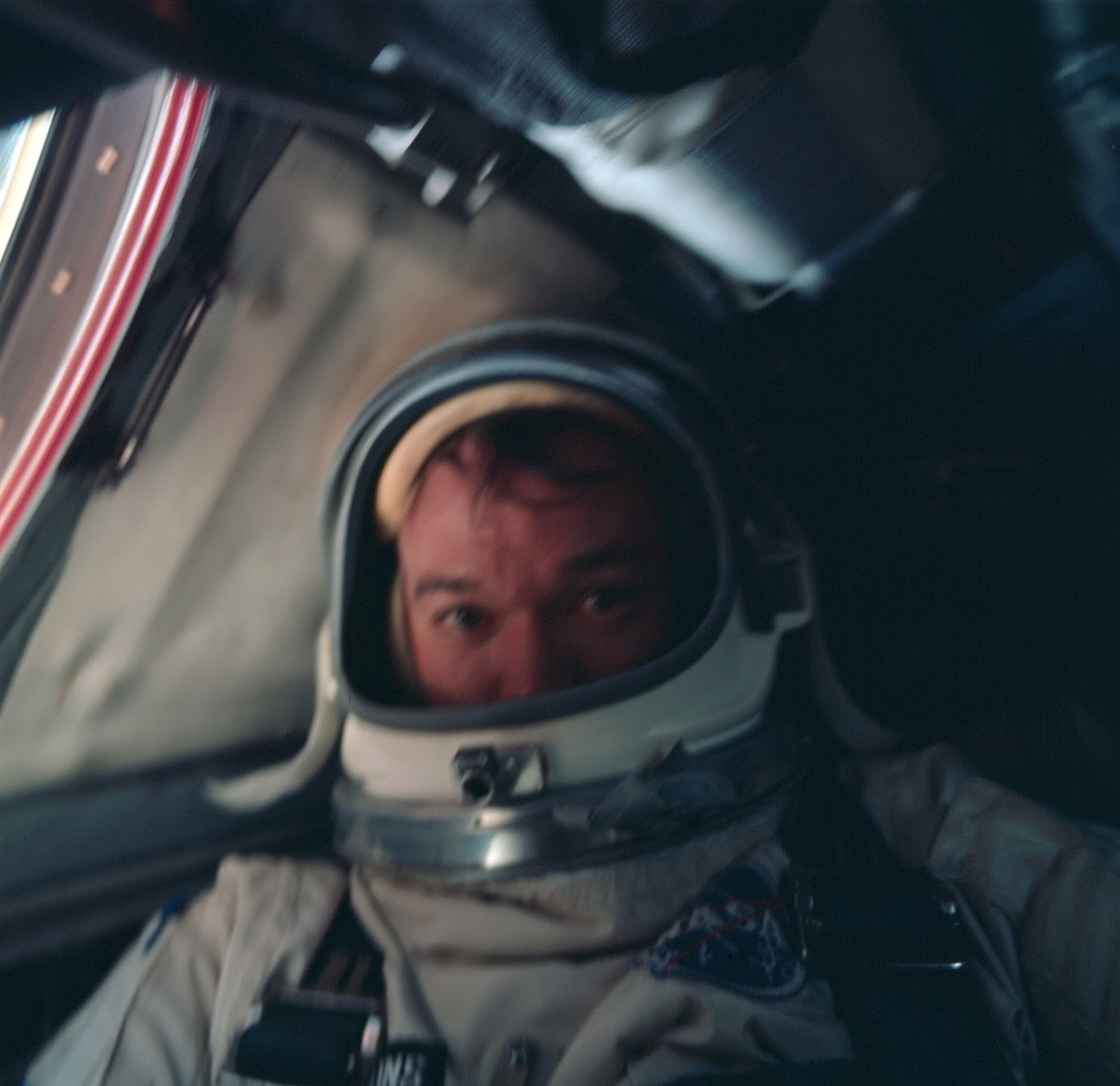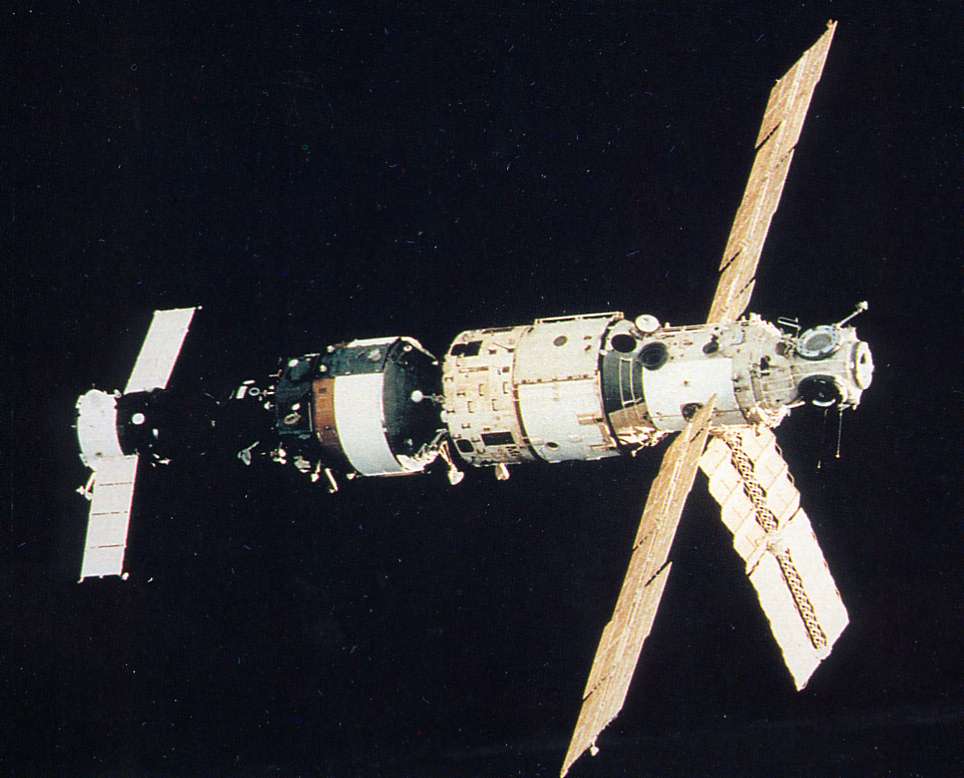 |
| From July 18, 1966: “Astronaut Michael Collins, command pilot, is photographed inside the spacecraft during the Gemini 10 mission.” NASA photo. |
The late 1980s represented a transitional time for both the U.S. and Soviet space programs. In January 1986, an unspeakable tragedy was etched all over the skies of Central Florida, signaling the fiery demise of Challenger; a lengthy investigation and redesign of many facets of the space shuttle program followed. Meanwhile, the Soviets focused on developing a space shuttle of their own (Buran), while also building infrastructure in space (Mir, their first modular space station, which stayed in orbit through 2001).
Two books, both released in 1988, address many of the issues associated with this era in spaceflight, while casting a witty, sometimes critical eye at both countries’ past glories. Both authors, despite writing about programs that exist on two sides of the world, managed to find common ground – and some of their words were chillingly prophetic.
Michael Collins’ Liftoff: The Story of America’s Adventure in Space (NASA/Grove Press)
“A space flight begins when the technician snaps your helmet down into your neck ring and locks it in place.” – Michael Collins
If you’re thinking the author’s name sounds familiar, you’d be correct – this is the same Michael Collins who performed an EVA on Gemini 10, and orbited the Moon during Apollo 11. Most space buffs associate Collins with his 1973 autobiography, the classic Carrying the Fire. While it can be agreed that book is one of the best in the canon, this is not its sequel. Liftoff functions less as a life story, and more as a chronological history of the U.S. space program from its nascent beginnings to the time of its publication.
Collins does candidly discuss his personal experiences as an astronaut, and, of course, his two iconic missions. However, Liftoff is at its best when Collins explains the technological and political factors influencing the design of early spacecraft, why certain spacecraft designs were favored over others, and concepts in aeronautics (such as the Apollo command module’s lift-to-drag ratio, and why it was chosen) that may be difficult for non-engineers to understand.
The book is also peppered with sometimes hysterical anecdotes about his astronaut colleagues. The Skylab/ASTP section, entitled “Life in Orbit,” was a nice surprise for this Apollo Applications fan. Allegedly Skylab 2 commander, Charles “Pete” Conrad, claimed he was able to traverse the whole length of Skylab without touching its sides. Collins wrote, “I asked his crewmate [Skylab 2 science pilot] Joe Kerwin about this, and he reacted more like a fighter pilot than a medical doctor (Joe is both). ‘Bullshit!’ he cried. ‘Undocumented! That’s like a guy going out on a golf course by himself and claiming he shot a hole in one.’” At any rate, it was nice to have an author at least acknowledge those two programs existed, as they are frequently glossed over or not mentioned at any length in space literature.
Some of Collins’ words prove to be eerie. His chapter on the space shuttle does not shy away from criticisms of the shuttle “system.” However, its last sentence made me gasp: “The Hubble’s [Hubble Space Telescope] successful launch will, I feel, be the most important piece of work that NASA has done in recent years, and one I hope will herald the Agency’s return to the forefront of science and exploration. It will be an institutional as well as a scientific milestone.” While Hubble eventually did unveil the mysteries of the Universe, its 1990 launch couldn’t exactly be called “successful.” Collins book shed more light upon NASA’s troubled late 1980s and early 1990s than a lot of contemporary books dared.
Phillip Clark, The Soviet Manned Space Program (Orion Books, 1988; also published in the U.K. as The Soviet Manned Space Programme)
“In its early years, the Soviet programme was shrouded in secrecy, with only scraps of information being officially released. As a result, it was the subject of much speculation in the West; some observers viewed it as an enterprise geared simply towards beating the Americans at all costs, while others saw a slow, stumbling program based on a greatly inferior technology.” – Phillip Clark
As early as the book’s introduction, space historian Phillip Clark exposed the reader to many of the fallacies associated with the Soviet space program, including the two alluded to in the previous quote. Many Westerners’ views of their program were clouded by memories of the ultra-competitive “Space Race,” or unfortunate past accidents including Soyuz 1 and Soyuz 11. Many stories about the Soviet efforts to fly to the Moon had not even been discussed in detail, as many were not even aware of what the N-1 rocket was. The Soviet space program was as closed as ours was open.
Enter this 1988 volume: Clark’s Soviet Manned Space Program singlehandedly dismantled many of my incorrect notions about Soviet spaceflight. As an American growing up in the 1980s, I remember many news reports about Soviet space launches lacked even the most basic information other than, “Yesterday a space station launched.” I believe for many space enthusiasts, including me, this book was a huge eye-opener.
 |
| An earlier view of Mir. “A view of Mir from Soyuz TM-2 showing the station in its early configuration. In view (from left to right) are the Base Block, Kvant-1 module and docked Soyuz TM-3 spacecraft.” Photo from www.capcomespace.net |
Clark discusses Soviet space history through 1988 while providing context on the decisions that motivated their rocket pioneers, designers, and cosmonauts. The book is also notable in that it provides excellent orbital charts, then-rare photographs, and detailed diagrams of spacecraft. This is where I first discovered what Mir actually looked like.
Clark underscored that while the United States focused upon lunar missions in the 1960s, that country “soon abandoned” the technology that took them to the Moon. While the Soviets did not reach the Moon, they did focus on “a slowly evolving space station programme during the 1970s and 1980s.” Clark added, “…[By] 1990 it should have developed the Mir complex to be the equal of the American space station programme which will not be complete until the latter half of the 1990s.” The Soviets’ long heritage of lengthy space station missions cannot be discounted in their importance.
His words, too, proved to be somewhat prophetic: the United States would lag far behind the Russians in establishing their own space outpost during this era. During the early-to-mid 1990s, “Phase One” of the International Space Station (ISS) program took U.S. astronauts to Mir with mixed results, while the collaborative ISS wouldn’t be permanently occupied until 2000.
Where Are The Authors Now?
Michael Collins was most recently seen at Spacefest VIII in Tucson, Arizona, and he seems to be enjoying fishing, painting, and retirement. Clark is still actively writing, continues to be involved with the British Interplanetary Society (BIS), and recently contributed an article about China’s space station program to their magazine, the August issue of Spaceflight.
Emily Carney is a writer, space enthusiast, and creator of the This Space Available space blog, published since 2010. In January 2019, Emily’s This Space Available blog was incorporated into the National Space Society’s blog. The content of Emily’s blog can be accessed via the This Space Available blog category.
Note: The views expressed in This Space Available are those of the author and should not be considered as representing the positions or views of the National Space Society.


















